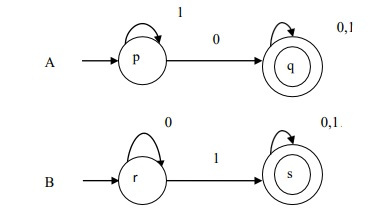
 Data Structure
Data Structure Networking
Networking RDBMS
RDBMS Operating System
Operating System Java
Java MS Excel
MS Excel iOS
iOS HTML
HTML CSS
CSS Android
Android Python
Python C Programming
C Programming C++
C++ C#
C# MongoDB
MongoDB MySQL
MySQL Javascript
Javascript PHP
PHP
- Selected Reading
- UPSC IAS Exams Notes
- Developer's Best Practices
- Questions and Answers
- Effective Resume Writing
- HR Interview Questions
- Computer Glossary
- Who is Who
Explain the intersection process of two DFA’s
According to the theorem, If L and M are two regular languages, then L ∩ M is also regular language.
Example
Construct A∩B where A and B is given as follows −

The language A ={10,100,00,001,1010,…..}
The language B ={01,1010,10,101,…..}
AA = (QA, Σ, δA, qa, FA) AB = (QB, Σ, δB, qB, FB) A∩B=(QA x QB ,Σ,δ(qA x qB ,FA x F B )
Where,
δ(( p, q), a) =δL (p, a), δM (q, a))
Here, QA x QB = {p,q} x {r,s}
={(p, r), (p, s), (q, r), (q, s)}
Z = {0, 1}
qA x qB = {p, r}
FA x FB = {q, s}

The finite automaton is given below −


Advertisements
